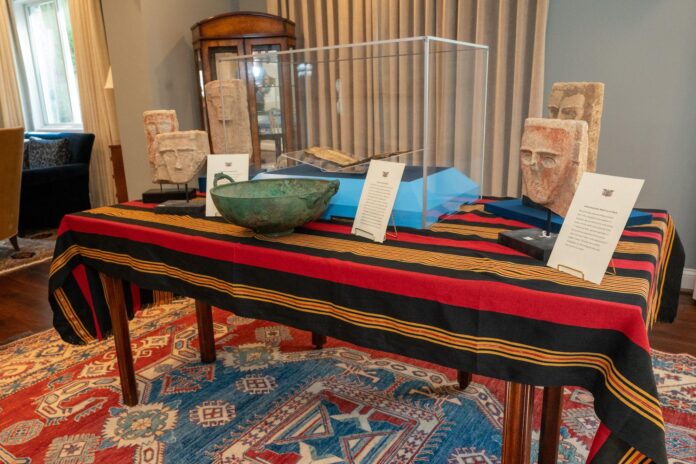In an unusual instance of shared stewardship of cultural objects, the Smithsonian Institution’s National Museum of Asian Art is forging a partnership with the government of the Republic of Yemen to temporarily house artefacts looted from the country. Investigators in the United States seized the 77 objects from several sources and returned them to Yemen, but due to the ongoing humanitarian crisis there, turned them over to the Smithsonian after a repatriation ceremony held yesterday (21 Feb).
The two-year, extendable custodial agreement permits the Washington, DC museum to store, care for and exhibit the objects, under the advice of the embassy. It comes as Yemen is about to enter its ninth year of civil war, with Iran-backed Houthi rebels continuing to devastate and control much of the country. As a result of this conflict, Yemen has experienced heavy looting and destruction of its cultural heritage since 2014.
“With the current situation in Yemen, it is not the right time to bring the objects back into the country,” Mohammed Al-Hadhrami, the ambassador of the Republic of Yemen to the US, said in a statement. “The Smithsonian’s National Museum of Asian Art is a global leader in the field of cultural heritage and preservation. We are pleased to see these objects in their care.”

Inscribed bronze bowl with two handles. Courtesy Homeland Security Investigations New York.
The objects include a bronze inscribed bowl, believed to be from the 3rd century, and 11 folios from an 8th century Qur’an. Some of the manuscripts were discovered by Customs and Border Protection officers at Philadelphia International Airport, and others were seized from an online sale during a sting operation, according to The Washington Post.
The other 65 objects are funerary stelae from northwest Yemen that date to the second half of the first millennium BCE. Of these, all but one were forfeited to US authorities in connection with an Eastern District of New York civil forfeiture action related to the April 2012 guilty plea of an antiquities smuggler. The smuggler, Mousa Khouli, also known as “Morris Khouli”, was charged with illegally importing and selling antiquities from countries including Yemen, Egypt and Iraq.
Many objects seized in that case were subsequently repatriated to Egypt in 2015, but the stelae—stone slabs with relief carvings of heads with wide-open eyes—have since been held in storage, The New York Times reported. The collection may provide a better understanding of ancient south Arabian funerary practices and the study of names, as some items bear the inscriptions of the name of the deceased. Others still show traces of pigment.

Folio from an early Qur’an. Courtesy Homeland Security Investigations New York.
As museums face mounting pressure to give stolen property back to their countries of origin, restitution has been complicated by questions regarding the rightful owners’ ability to safeguard the objects. In April 2022, the Smithsonian sought to address these issues by adopting a formal policy on ethical returns. The policy authorises its museums to return items from collections based on ethical considerations and allows for shared stewardship arrangements, such as this new partnership with Yemen.
This week’s repatriation marks the first time in nearly two decades that the US government has returned cultural property to Yemen. Previously, authorities returned a single funerary stele to the Yemeni embassy in 2004.
Approached by the State Department and the Yemeni Embassy about the partnership in January, the National Museum of Asian Art is already home to dozens of objects from Yemen, gifted by the collector Joseph H. Hirshhorn. Many are on view in the exhibition Ancient Yemen: Incense, Art, and Trade, which opened last September. A selection of the repatriated objects may join the display. The museum says that it plans to engage with the Yemeni community to inform the interpretation of these objects in the exhibition. Object labels will also call attention to their provenance and the ongoing war in their origin country.
“As the museum enters its second century, we are focused on new approaches that allow visitors to deepen their understanding of Asian arts and cultures,” the museum’s director Chase F. Robinson said in a statement. “Our partnership with the Republic of Yemen Government and its embassy is a powerful example of how shared stewardship of objects can build bridges and serve as a catalyst for learning and understanding, and we look forward to working with the Yemeni community to tell their stories.”

























